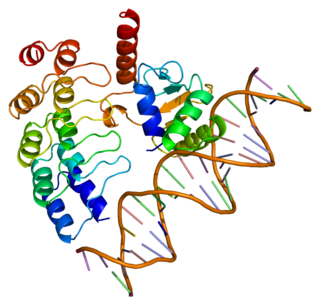
Ferritin is a universal intracellular protein that stores iron and releases it in a controlled fashion. The protein is produced by almost all living organisms, including archaea, bacteria, algae, higher plants, and animals. It is the primary intracellular iron-storage protein in both prokaryotes and eukaryotes, keeping iron in a soluble and non-toxic form. In humans, it acts as a buffer against iron deficiency and iron overload.

MT-ND6 is a gene of the mitochondrial genome coding for the NADH-ubiquinone oxidoreductase chain 6 protein (ND6). The ND6 protein is a subunit of NADH dehydrogenase (ubiquinone), which is located in the mitochondrial inner membrane and is the largest of the five complexes of the electron transport chain. Variations in the human MT-ND6 gene are associated with Leigh's syndrome, Leber's hereditary optic neuropathy (LHON) and dystonia.

MT-ND4 is a gene of the mitochondrial genome coding for the NADH-ubiquinone oxidoreductase chain 4 (ND4) protein. The ND4 protein is a subunit of NADH dehydrogenase (ubiquinone), which is located in the mitochondrial inner membrane and is the largest of the five complexes of the electron transport chain. Variations in the MT-ND4 gene are associated with age-related macular degeneration (AMD), Leber's hereditary optic neuropathy (LHON), mesial temporal lobe epilepsy (MTLE) and cystic fibrosis.

MT-ND2 is a gene of the mitochondrial genome coding for the NADH dehydrogenase 2 (ND2) protein. The ND2 protein is a subunit of NADH dehydrogenase (ubiquinone), which is located in the mitochondrial inner membrane and is the largest of the five complexes of the electron transport chain. Variants of human MT-ND2 are associated with mitochondrial encephalomyopathy, lactic acidosis, and stroke-like episodes (MELAS), Leigh's syndrome (LS), Leber's hereditary optic neuropathy (LHON) and increases in adult BMI.

Gamma-aminobutyric acid receptor subunit gamma-2 is a protein that in humans is encoded by the GABRG2 gene.

Nuclear transcription factor Y subunit alpha is a protein that in humans is encoded by the NFYA gene.

GA-binding protein alpha chain is a protein that in humans is encoded by the GABPA gene.

MT-ND1 is a gene of the mitochondrial genome coding for the NADH-ubiquinone oxidoreductase chain 1 (ND1) protein. The ND1 protein is a subunit of NADH dehydrogenase, which is located in the mitochondrial inner membrane and is the largest of the five complexes of the electron transport chain. Variants of the human MT-ND1 gene are associated with mitochondrial encephalomyopathy, lactic acidosis, and stroke-like episodes (MELAS), Leigh's syndrome (LS), Leber's hereditary optic neuropathy (LHON) and increases in adult BMI.

Clathrin heavy chain 1 is a protein that in humans is encoded by the CLTC gene.

4F2 cell-surface antigen heavy chain is a protein that in humans is encoded by the SLC3A2 gene.

Ferritin light chain is a protein that in humans is encoded by the FTL gene. Ferritin is the major protein responsible for storing intracellular iron in prokaryotes and eukaryotes. It is a heteropolymer consisting of 24 subunits, heavy and light ferritin chains. This gene has multiple pseudogenes.

40S ribosomal protein S27a is a protein that in humans is encoded by the RPS27A gene.

6-phosphofructokinase, liver type (PFKL) is an enzyme that in humans is encoded by the PFKL gene on chromosome 21. This gene encodes the liver (L) isoform of phosphofructokinase-1, an enzyme that catalyzes the conversion of D-fructose 6-phosphate to D-fructose 1,6-bisphosphate, which is a key step in glucose metabolism (glycolysis). This enzyme is a tetramer that may be composed of different subunits encoded by distinct genes in different tissues. Alternative splicing results in multiple transcript variants. [provided by RefSeq, Mar 2014]

Interleukin 13 receptor, alpha 1, also known as IL13RA1 and CD213A1, is a human gene.

Myosin-11 is a protein that in humans is encoded by the MYH11 gene.

Gamma-aminobutyric acid receptor subunit rho-1 is a protein that in humans is encoded by the GABRR1 gene.

Cytochrome b-c1 complex subunit 1, mitochondrial is a protein that in humans is encoded by the UQCRC1 gene.

Interleukin-2 receptor subunit beta is a protein that in humans is encoded by the IL2RB gene. Also known as CD122; IL15RB; P70-75.

Gamma-aminobutyric acid receptor subunit rho-2 is a protein that in humans is encoded by the GABRR2 gene.

Mitochondrial ferritin is a ferroxidase enzyme that in humans is encoded by the FTMT gene.































